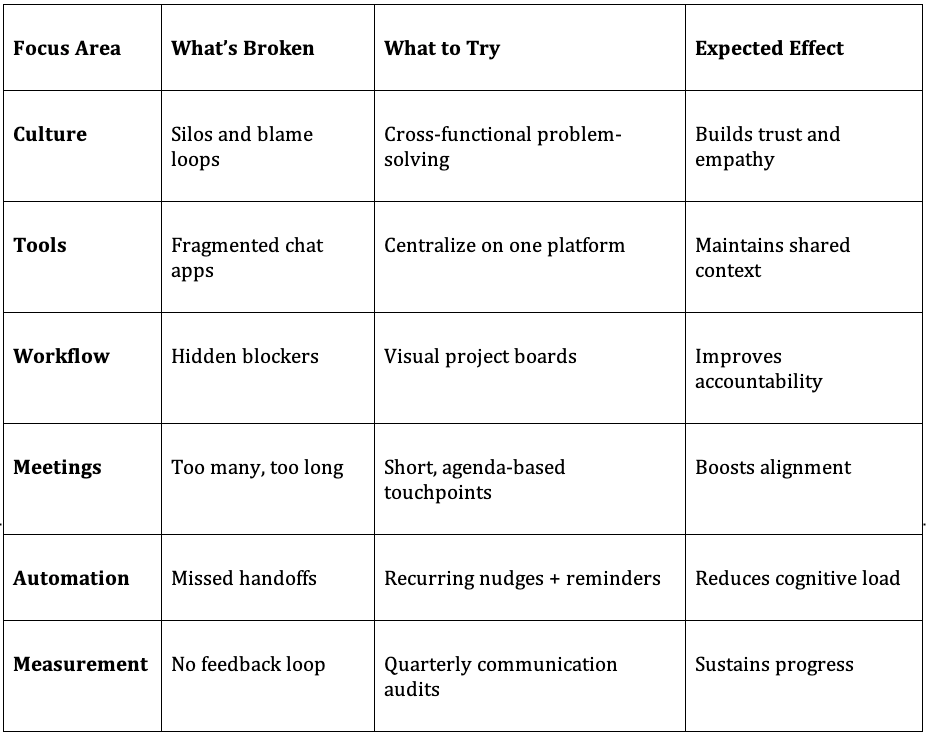The Quiet Fix That Will Save Interdepartmental Communication
When departments drift into isolation, miscommunication becomes the default. Deadlines slip. Friction blooms. Collaboration stalls. But the problem isn’t the people — it’s the structure.

When departments drift into isolation, miscommunication becomes the default. Deadlines slip. Friction blooms. Collaboration stalls. You’ve seen it: marketing blames product, product shrugs at sales, and leadership spins trying to hold it together.
But the problem isn’t the people — it’s the structure. Strong interdepartmental communication doesn’t happen by chance; it’s built through intentional systems, healthy friction, and the discipline to choose clarity over convenience when it matters most.
Build a Collaborative Culture
You don’t need a corporate retreat to build trust, but you do need time for teams to step outside deliverables. Cross-functional problem-solving in low-pressure settings reveals how different minds approach the same challenge.
When people see how others think, they stop viewing departments as bottlenecks and start viewing them as allies. The next time a deadline feels tight, the instinct isn’t to blame — it’s outreach. That’s the cultural shift: from siloed defensiveness to shared forward motion.
Centralize Communication Platforms
Every team has its sacred tool. Developers love one chat app, ops another, HR clings to email. Left unchecked, that fragmentation becomes a quiet tax on clarity. If your team needs four apps to find one message, they won’t find it. The fix isn’t more channels, it’s fewer.
A central communication hub gives everyone the same map. Not every message needs a meeting, and not every update needs a Slack thread. When everyone shares one platform, context stays intact and collaboration stays effortless.
Make Workflow Visibility the Default
Communication isn’t just conversation — it’s structure. For teams managing cross-functional projects, a visual source of truth changes everything.
Workflow management tools make accountability visible. Who’s responsible? What’s the deadline? Where’s the blocker? When those answers live on a shared board, not buried in threads, surprises disappear and teamwork becomes rhythmic, not reactive.
Break Down Silos
Silos don’t appear overnight; they calcify through unspoken norms, hidden gatekeepers, and unwritten rules. Most people don’t even realize they’re inside one until something breaks. Leaders have to name the pattern first. When knowledge gets hoarded, people waste hours duplicating work. One team builds what another already finished — a classic symptom of information silos.
The fix isn’t more control — it’s more connection. Create spaces, digital or physical, where anyone can ask, “Who’s already working on this?” and expect a real answer.
Hold Smarter, Shorter Meetings
No one wants another meeting. But everyone wants clarity. The key isn’t more meetings — it’s better timing and purpose. Don’t meet because it’s Monday. Meet because something changed.
When meetings have structure, they stop being time sinks and start being alignment engines. Predictability gives people room to focus, engage, and then get back to meaningful work. Short, rhythmic meetings are pulse checks, not post-mortems.
Automate the Follow-Through
Some communication friction isn’t about people, it’s about process. When handoffs fall apart, the issue often isn’t effort, it’s workflow. Automation tools reduce cognitive load and make updates automatic.
Recurring reminders, tagged approvals, and structured feedback loops ensure no one drops the ball. Automation becomes a quiet signal of respect: “We value your time enough to protect it.”
Keep Measuring What Matters
Healthy communication is a moving target. Teams change, org charts shift, and new tools emerge. If you’re not measuring, drift is inevitable.
A quarterly communication audit helps spot breakdowns before they spread — from message gaps to role confusion. It’s not an inspection. It’s maintenance. You’re not looking for fault; you’re checking for alignment.
The Bottom Line
Better interdepartmental communication doesn’t mean more meetings or more apps. It means less noise, fewer assumptions, and more trust.
When clarity becomes culture, teams stop competing and start connecting. You won’t get it perfect — but you can get it working. And when it works, everything else starts to hum.
Quick Reference Table

FAQ: Fixing Communication Friction
Q1: What’s the first step to improving interdepartmental communication?
Start by identifying where messages break down — in tools, tone, or timing. Awareness always precedes alignment.
Q2: How do we get everyone to use the same platform?
Pick one primary channel, make it official, and reinforce it through practice — not policy.
Q3: What’s one change that creates immediate impact?
Add visual workflow tracking. When responsibilities are visible, accountability follows naturally.
Q4: How can leaders sustain progress?
Schedule quarterly communication audits. Treat them as tune-ups — not investigations.


